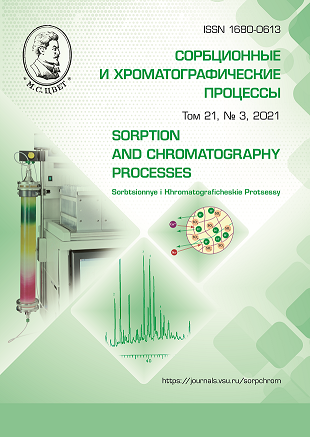Influence of catalytic additives on the process of the production of carbon sorbents from chipboard waste
Abstract
The study presents the results of the research devoted to the processing of large-tonnage polymer chipboard waste (hereinafter referred to as chipboard) by the low-temperature pyrolysis method in the presence of catalytic additives: transition metal salts (Cu+, Ni2+) and potassium hydroxide. The study analyses the scientific and technical information of known methods for processing polymer waste and methods of the production of carbon sorbents using various reagents. The aim of this study was the investigation of the effect of catalytic additives of transition metal salts (Cu+, Ni2+) and potassium hydroxide on the physicochemical, sorption and textural characteristics of pyrolysates obtained from polymer chipboard waste.
The authors present the results of laboratory studies using modern analytical measurement methods and equipment. The analysis of the porous structure of pyrolysates was based on nitrogen adsorption (77 K) using a Quantachrome NOVA 4200e gas sorption analyser. The total content of metals was measured based on the atomic absorption according to the M-02Vd/2001 method using a KVANT-2MT flame atomic absorption spectrophotometer. The X-ray microanalysis method using a Hitachi S-3400N (Japan) scanning electron microscope, equipped with a NORAN X-ray energy dispersive spectrometer was used to obtain images at a magnification of x1000. Also, for research, we used standard techniques adopted in adsorption technology: spectrophotometric, titrimetric, potentiometric methods, etc. The study presents the results of thermochemical utilization of polymer chipboard waste, where the parameters of the pyrolysis process were established. The optimal mass ratio of chipboard waste: catalyst was 1:0.02, pyrolysis temperature was 600-700oC, at a rate of 10-12 deg/min, exposure time was 30-60 min. In this study, the influence of the pyrolysis conditions in the presence of KOH and without it on the formation of the porous structure and the sorption properties of the obtained samples were investigated. The maximum practical yield was determined for chipboard: KOH (1:0.02) – 34%, Sorption characteristics – sorption of iodine – 763±25 mg/g, sorption of MG – 200±11 mg/g.
It was found that the introduction of catalysts affects the practical yield, sorption properties and parameters of the porous structure. Thus, the introduction of the catalysts to the Cu+ and Ni2+ system allowed increasing the product yield from 20 to 25%. The introduction of a nickel catalyst into the chipboard: Ni2+ (1:0.02) system allowed increasing the sorption of iodine by pyrolysates by 40%. The volume of micropores was 0.203 cm3/g, the surface area of micropores was 562 m2/g. Scanning electron microscopy showed that pyrolysates without catalysts had a layered ordered structure similar in properties to wood, the pore size was 10-50 nm. After the introduction of catalysts, the impairment of the structure of coals was observed; in chipboard: Ni2+ (1:0.02) samples and chipboard: under the influence of Cu2+(1: 0.05) smaller pores of irregular shapes from 2.5 nm in size were formed. Based on the results of the study, it can be concluded that the introduction of catalytic additives of transition metal salts (Cu+, Ni2+) and potassium hydroxide affects the physicochemical properties, the porous structure of pyrolysates and their textural characteristics. The proposed method allows obtaining pyrolysates, possessing sorption properties similar in characteristics to industrial brands of charcoal of BAU-MF type in one stage.
Downloads
References
Beschastnov A.V. Tendencii za-meshheniya ipotencial rosta: fanera, OSB, DSP, MDF. аvailableat: https://proderevo.net/events/all/details/2018-11-20/45. (accessed 12.10.2020).
Leonovich A.A. Tehnologiya drevesny`xplit. St Peterburg, Lan`, 2019, 180 p.
Mashanov A.V., Shevczov D.G., Sov-remenny`etexnologiinauchno-texnicheskij progress, 2015, Vol.1, No 1, pp. 98-100.
Zhang J., Choi Y.S., Yoo C.G., Kim T.H. et al., ACS Sustainable Chem. Eng., 2015, Vol. 3(2), pp. 293-301.
Sister V.G., Lugovoj Yu.V., Kosivczov Yu.Yu., Sul`man E`.M. et al., Zhurnal fizi-cheskoj khimii, 2011, Vol. 85, No 6, pp. 1192-1194.
Butler E., Devlin G., Meier D., McDon-nell K., Renewable and sustainable energy reviews., 2011, Vol. 15(8), pp. 4171-4186, doi.org/10.1039/C1CS15124J 11.
Qinghong Kong, Ling Yang, Junhao Zhang, Yibing Cai, General Chemistry, 2017, Vol. 3(3), pp.155-158.
Singh R.K. Pyrolysis and catalytic crack-ing of municipal plastic waste for recovery of gasoline range hydrocarbons, Rourkela, 2007, Vol. 1, 46 pp.
Rehan M., Miandad R., Barakat M.A., Ismail I.M.I. et al, International Biodeterio-ration & Biodegradation, 2017, Vol. 119, pp. 162-175.
Nizami A.S., Ouda O.K., Rehan M., El-Maghraby A.M.O. et al. Energy, 2016, Vol. 108, pp. 162-171.
Ratnasari D.K., Nahil M.A., Williams P.T., Waste Manag., 2017, Vol. 124, pp. 631-637.
Petrov M.E., Lugovoj Yu.V., Kosivczov Yu.Yu., Molchanov V.P., ″Razrabotka resursosberegayushhej texnologii kataliticheskogo piroliza otxodov polimerny`x materialov s poluchenieme` nergiiiuglerodny`x sorbentov″, Proceedings of the II International Conference, March 23-24, 2020, Tver`, 2020, pp. 318-324.
Zhou C.H., Xia X., Lin C.X., Tong D.S. et al., Chemical Society Reviews, 2011 Vol. 40(11), pp. 5588-5617.
Oliveux G., Dandy L.O., Leeke G.A., Progress in Materials Science, 2015, Vol. 72, pp. 61-99.
Chalov K.V. Patent RF, No 2617213, 2012.
Stupin A.B., Man`ko K.I., Vіsnik donecz`kogo naczіonal`nogo unіversitetu, Ser. A: Prirodnichіnauki, 2008, No 2, pp. 299-301.
Sazanov Yu.N., Gribanov A.V. Kar-bonizaciyapolimerov, St. Peterburg, NOT, 2013, 296 p.
Komisarenkov A.A., Fedorova O.V. Sorbcionny`e texnologii. Opredelenie svojstv sorbentov, Saint Petersburg, 2015, Vol. 1, p. 4







